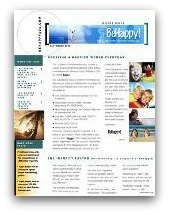Do You Want (or Need) a Higher Income?
(Part 5)

Nearly all successful people plan for success. Just achieving a goal requires a plan. Otherwise, you just have to “wing it” and rely mostly on luck to get what you want in life. That’s generally not a good approach.
If you want (or need) a higher income – and
especially if you want to build wealth, with a multi-million dollar net worth – you must
create a detailed plan to make it happen. That's what this session is all about.
In fact, ignoring money for a moment, even if you want to "just" be happy (which I assume is the case since you are visiting this website) you need a Happiness Plan to get there. There is a complete roadmap to creating your life’s Happiness Plan in the book – BeHappy! – which you can get by clicking here.
From an income and financial perspective, the process is similar to creating any other plan, but obviously focused on money, income, and wealth.
Planning for Wealth
Creating an income and wealth plan for your life is
not too difficult. From a very big
picture or high level perspective, building wealth over time involves 3 basic
steps. Those 3 steps are:
- Establish an initial positive personal cash flow of at least 20% (in other words, generate an income which exceeds your expenses by at least 20%).
- Save at least 10% of your income.
- Invest at least 10% of your income.
Let's take a brief look at each step...
1. Establish a Positive Personal Cash Flow
In this 5-part series, you hopefully learned some of the basic ways to start achieving this first of these 3 steps.
Specifically, we discussed (1) increasing the income from your current job or Primary Source of Income (Part 3), and (2) establishing a multiple streams of income strategy (Part 4). That’s the first half of step 1, and if you do it right (with the right plan), you can start to really gain some income momentum over a relatively short period of time (from a few months to a few years, depending on your strategy and plan).
The second half of step 1 is to make sure the income you generate from your various sources of income is at least 20% greater than your total annual expenses. If that’s not the case, then part of your wealth-building plan must include an expense-reduction component in addition to an income-increasing component (at least temporarily).
That’s right. It will be difficult to improve your financial life if you don’t establish a positive cash flow (unless you already have a net worth which can support your current lifestyle indefinitely, but if that were the case, I doubt you would still be reading these posts).
Certainly, increasing your income is part of the process to a positive cash flow, and if you can create a positive cash flow just by increasing your income alone, while continuing your current spending, that’s great. If not, you must make a change, so click here to explore the basics of budgeting and money management.
2. Saving 10% of Your Income
The second step of the "simplistic" process outlined above is very simple, but not always easy to do (especially if you're barely making ends meet).
You have to place 10% of your monthly after-tax income into a secure (no-risk), preferably interest-bearing savings vehicle of some sort. You can put it as cash in the bank, in a CD (Certificate of Deposit) or even under your mattress (not recommended). The point is, it needs to be put in a no-risk place. Importantly, too, is that this must be done with every paycheck – or with whatever method of income you receive regularly – and it must be done before you pay your bills.
So, if you get paid $2,000 after taxes every two weeks, for example, then before you do anything, you must put $200 (10% of $2,000) every two weeks into this "savings" account. This would give you over $400 per month – which equates to about $5,000 per year in savings. Again, if you can’t afford to put this $200 into savings, then go back to step number 1 to create a positive cash flow of at least 20% - either by increasing your income to the point required and/or decreasing your expenses to the necessary level.
Click here to find out more about various saving strategies and sources.
3. Investing 10% of Your Personal Income
Once you have addressed the first two steps (and only then) you can accelerate your income and wealth-building process by investing 10% of your monthly income. Again, though, this must be done only after you put the first 10% of your monthly positive cash flow (income) into savings and only with the 10% surplus you have established by having a 20% overall positive cash flow (after tax).
Investing requires education. You should not just start putting your excess income into the stock market, real estate, or even mutual funds and gold without first doing some homework and preparation. Even if you have a financial planner doing your investing, it is best practice to know the basics of your investment portfolio yourself.
In general, it’s best to divide up your 10% investment fund into conservative, moderate, and aggressive components (in approximately equal parts). Using the example above where you generate a $2,000 paycheck every two weeks after tax, you would take the $200 investment fund (again, 10% of $2,000) and put about $66.00 in conservative investments, like mutual funds and/or gold, about $66.00 in moderate, more aggressive investments, such as income-producing real estate and/or corporate, government, or municipal bonds, and the final $66.00 into more speculative investments such as stocks, stock options, or futures (just remember, as with most investments, this money could be lost completely).
Again, this takes education, research, and a plan. You obviously can’t invest in much income-producing real estate, for example, with $66.00, but you can have a plan to put aside that $66.00 every month for 2-3 years and save that money on a down-payment on a piece of property. And, there are many other strategies for investing in real estate (like no-money down strategies) and all other investment vehicles. So, do your homework. Do the research. Get the advice of experienced professionals. Perhaps join an investment club (or start one yourself).

The point is that, to become wealthy, it generally takes a more
aggressive approach than just generating a comfortable income or even
having a regular savings plan. It usually requires taking informed,
calculated risks and maybe even stepping out of your comfort zone.
This is how the smart people get wealthy and, really, how “the rich get richer”.
Click here to learn more about specific investing strategies and sources.
PLEASE CONSIDER...
If the information on this site helps you and you'd like to make a donation to BeHappy101.com (to help make others happy), please click on the button below to make a contribution. The amount you donate is entirely up to you. A portion will used to contribute to the happiness of others and is greatly appreciated. [WHY DONATE?] |







 I'm Jimmy, the founder and creator of this site and the whole BeHappy! system. My life's purpose is to be a positive, creative force for health and happiness and through this website, my books, coaching, and happiness-building programs, I intend to help as many people as possible live their happiest possible lives.
I'm Jimmy, the founder and creator of this site and the whole BeHappy! system. My life's purpose is to be a positive, creative force for health and happiness and through this website, my books, coaching, and happiness-building programs, I intend to help as many people as possible live their happiest possible lives.